Dawood remembers the disgust in the eyes of the Turkish security guards in the deportation center where he was held last year. “I felt like humanity had died,” said the soft-spoken Syrian man in his 30s, who is identified by a pseudonym to protect his safety. “They just kept shouting: ‘You are like animals! We’re tired of you. If you are a man, go back to Syria and fight!’”
The humiliation hit hard for Dawood, who does not lack courage or love for his country. Back in Syria, he volunteered as a rescue worker for the Syrian Civil Defence, also known as the White Helmets. For five years, Dawood dashed into burning buildings that had been bombed by the Bashar al-Assad regime and the Russians, risking his own life to save others, before finally escaping the Syrian province of Idlib in 2022 and settling in Istanbul — without valid papers.
“I tried to explain to those guards what Syrians have experienced,” Dawood told this reporter during an interview from the Syrian restaurant where he is now hiding. “But they said: ‘We don’t care. If you are going to die, just go die in Syria.’”
Dawood had ended up in the deportation center located just outside the Turkish city of Gaziantep after being apprehended while trying to cross illegally from Turkey into Bulgaria in September 2023. As he arrived at the facility close to the Syrian border on a bus packed with other Syrians, he saw a massive five-story complex surrounded by long walls topped with metal fences and barbed wire. By the entrance stood a faded sign that read, “This project is co-financed by the European Union.”
Upon arrival, Dawood had his phone confiscated and was told to queue up in front of a room. As he waited his turn, he recalled, the man who had stood in line in front of him was dragged out of the room by two plainclothes police officers and beaten up. Dawood was called in next. Inside the room, a woman in her 30s with dyed blonde hair sat behind a computer and told him to sign “some standard paperwork” to be able to retrieve his confiscated belongings later on. Dawood looked at the form in front of him and spotted the words “voluntary return to the Syrian Arab Republic.”
“I then told that woman that I want to speak to a lawyer, but she said that there’s no time for such things with so many people waiting in line,” Dawood recalled. “When I insisted, she began to threaten me, saying, ‘Do you really want me to call those police officers again?’”
Dawood’s account is not an aberrant incident. It is the dark side of the way that the EU outsources its migration management to third countries, and then looks the other way when refugees’ rights are violated. As the authors of this piece reported in a joint investigation coordinated by Lighthouse Reports, the EU has allocated at least 200 million euros in funding to the setting up and operation of a vast network of 32 “removal centers” in which migrants and refugees are abused, humiliated and forced to sign so-called “voluntary removal forms.” The investigation involved over half a year of reporting by more than 20 journalists from El Pais, NRC, Der Spiegel, Al Jumhuriya, Politico, Le Monde, L’Espresso, Etilaat Roz and the Syrian Investigative Reporting for Accountability Journalism (SIRAJ).
Since June 2023, Ankara says, authorities have deported 180,000 “irregular migrants” and 160,000 Syrians have “voluntarily returned” to their country. Turkey also saw riots last July in which thousands across the country set fire to Syrian homes, shops and other properties and attacked Syrians, leaving one 17-year-old Syrian boy dead. Such outbursts of racist violence, combined with the mass deportation campaign by the Turkish government, have transformed Turkey from a country once praised for hosting the world’s largest number of refugees to a place where those refugees hide inside their homes out of fear of being plucked off the street, detained and forcibly deported.
The EU shares responsibility for this crackdown in several ways. Not only has Brussels put immense pressure on Turkish society by striking deals with Ankara to keep millions of refugees inside Turkey, it has also funded a system of apprehending, detaining and removing migrants and refugees, our investigation has found. By reviewing hundreds of pages of internal EU documents obtained through a freedom of information request last year, we calculated that the EU committed 213 million euros to a dozen projects related to the removal centers, and were able to document in great detail what has been financed — from bed linen to barbed wire. Although we found clear evidence that EU officials are aware of reported abuses inside the centers, the funding has continued unabated — and Brussels is currently debating a new extension.
We also spoke with nearly 40 people who were (and in some cases still are) detained in the removal centers and auxiliary facilities. Corroborating individual testimonies with findings from visual evidence, public and internal EU documents and nongovernmental organization reports, we investigated conditions in the removal centers in great detail, and found overwhelming evidence of overcrowding, poor hygiene, beatings, racist abuse and suicide attempts, as well as reported deaths occurring under unclear conditions. While the Lighthouse investigation covered the experiences of both Syrians and Afghans — the two main groups of refugees in Turkey and those most often detained — New Lines focused specifically on Syrians.
In a response to written questions by Lighthouse, Ankara reiterated its commitment to the principle of non-refoulement embedded in both Turkish and international law, confirmed that this principle applied to Syria and maintained that, therefore, all returns to Syria were “voluntary, safe and dignified.” This investigation, however, found overwhelming evidence to the contrary, not just in the testimonies of forcibly deported Syrians, including many lawyers, but also in rulings by both the European Court of Human Rights and the Turkish Constitutional Court, and even admissions by current and former Turkish officials. One of these officials, an adviser to President Recep Tayyip Erdogan until last year, confirmed that in cases where people sent to Syria do not want to return, the government “sends them anyway.”
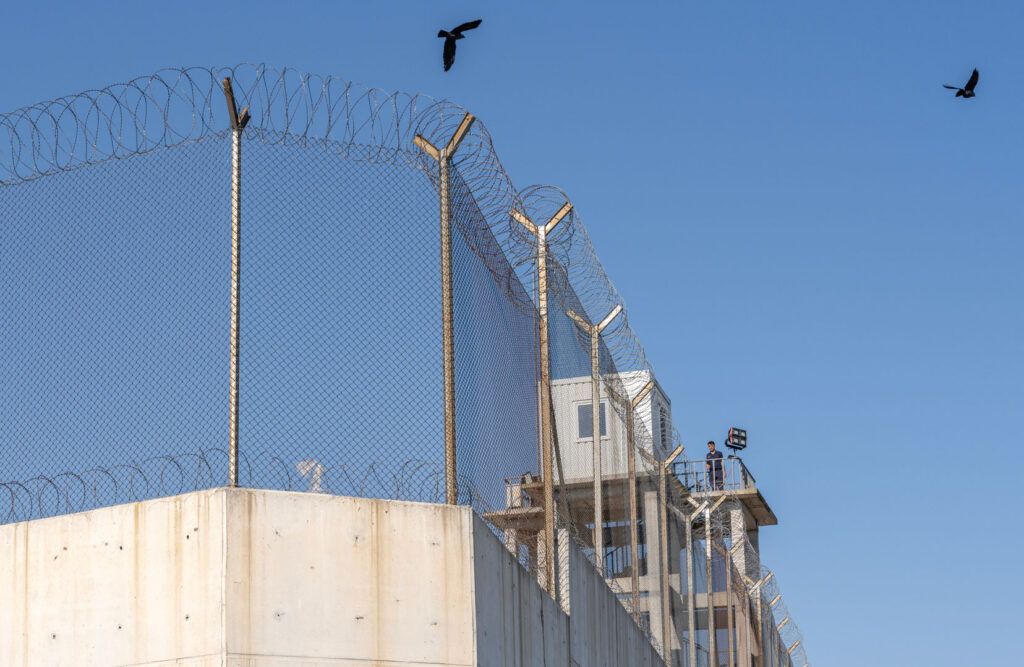
Ankara’s deportation machine has been running at full steam for many years now, but became overheated following the latest presidential elections in 2023. During that crucial vote, Erdogan came close to being ousted and was constantly attacked for his “soft stance” on migration. The main opposition party, the Republican People’s Party (CHP), has highlighted this topic since at least 2018, but this time, it went a step further, and allied itself with the so-called Victory Party, a far-right fringe party that calls for the mass deportation of the supposedly “13 million Syrians” in the country (in reality, there are over 3 million registered and at least hundreds of thousands of unregistered Syrians in Turkey). The result was a campaign filled with nationalist anger and racist rhetoric, with the CHP’s leader Kemal Kilicdaroglu describing refugees as an “uncontrolled flood that infiltrates our veins every day … and will one day threaten our survival.”
While Erdogan criticized the opposition’s tone, he ended up taking over their message, and equally promised to “ensure the return” of a million Syrians. When he was reelected with the narrowest margin since coming to power over 20 years ago, several sources in Ankara say his instructions to the new interior minister and director of the Presidency of Migration Management (PMM) were clear: control the border, crack down on irregular migration and curtail the number of Syrians. “Integration efforts have been put aside,” one of those sources, who is in frequent contact with the PMM, told the joint investigation on condition of anonymity. “The entire focus is now on deporting as many people as possible.”
To achieve that goal, the PMM launched a new flagship project in July 2023, straight after the election: the so-called mobile migration vehicles. There are currently 270 of these red-and-white vans in circulation, according to the interior minister. They patrol Turkey’s streets or wait outside bus and metro stations, looking for people who could be undocumented foreigners. “When these vehicles come, no one can go out,” Interior Minister Ali Yerlikaya boasted in an interview with the Turkish channel Haberturk in August this year. “Of course, I don’t mean the legal migrants who are registered,” he quickly added. “But for the others: As soon as they go out, we’ll catch them.”
For Afghan refugees in Turkey, it is very difficult to obtain international protection despite the Taliban takeover of Afghanistan in 2021, several diplomats and lawyers said. While Syrians qualify for “temporary protection” — a status created for them in 2013, when Turkey still welcomed refugees with open arms and Erdogan called them “my brothers” — they have to be registered in a specific province and have been barred from applying for this status in Istanbul, Ankara and 14 other provinces since 2022. Even those who do obtain legal status — acquiring the coveted ID card known as the “kimlik” — are still subjected to a range of restrictions that limit their access to the labor market and freedom of movement, such as a requirement to obtain advance “travel permission” before moving from one province to another.
One young Syrian man, a college student who goes by the name Ibrahim, recalled an ordeal when he was taken to a mobile migration vehicle at Gaziantep’s intercity bus station this summer, and failed to produce the required travel permission documents. “I told the guy that I was a student at a Turkish university and just came to Gaziantep to visit my sister who lives there,” Ibrahim said during a call with his sister heard by one of the authors. “But the guy told me: ‘We don’t give a shit. Follow me.’”
That same day, Ibrahim said, he was taken to a camp outside the town of Elbeyli, located by the Syrian border. “Every two hours, a bus comes here and is taking people to Syria,” Ibrahim said from inside the camp where, unlike Dawood, he was allowed to keep his phone. “They are beating us and telling us to sign a paper to say that we want to go to Syria. They even put me in a room with no water and told the guardian, ‘He can have water if he wants to go to Syria.’”
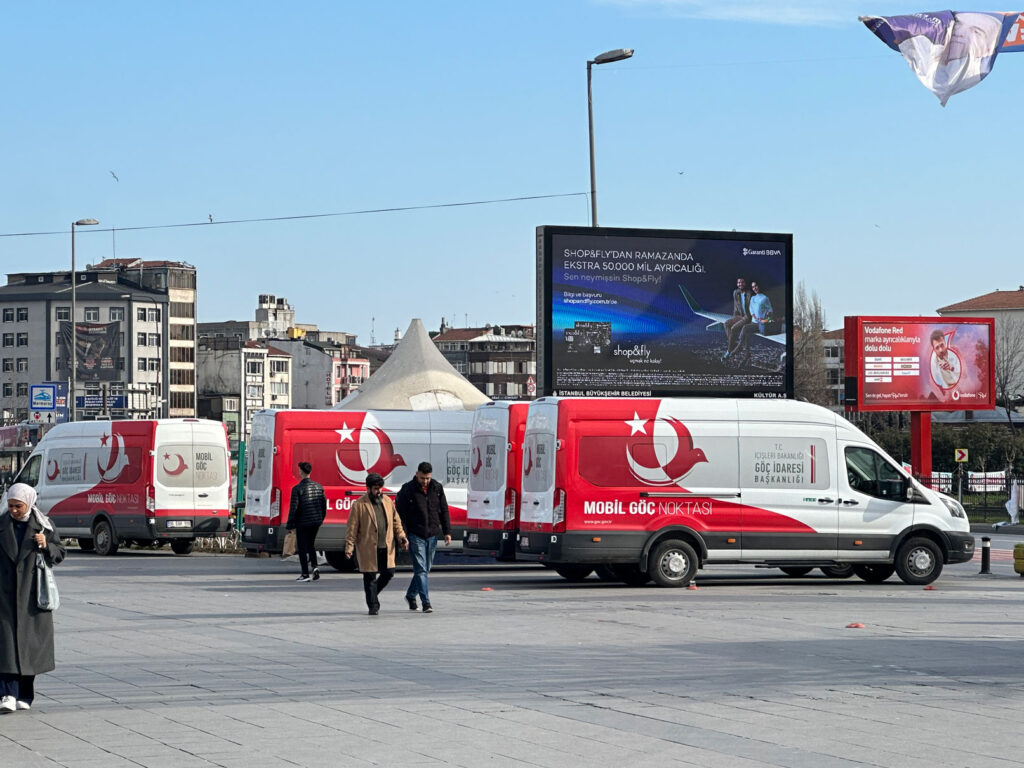
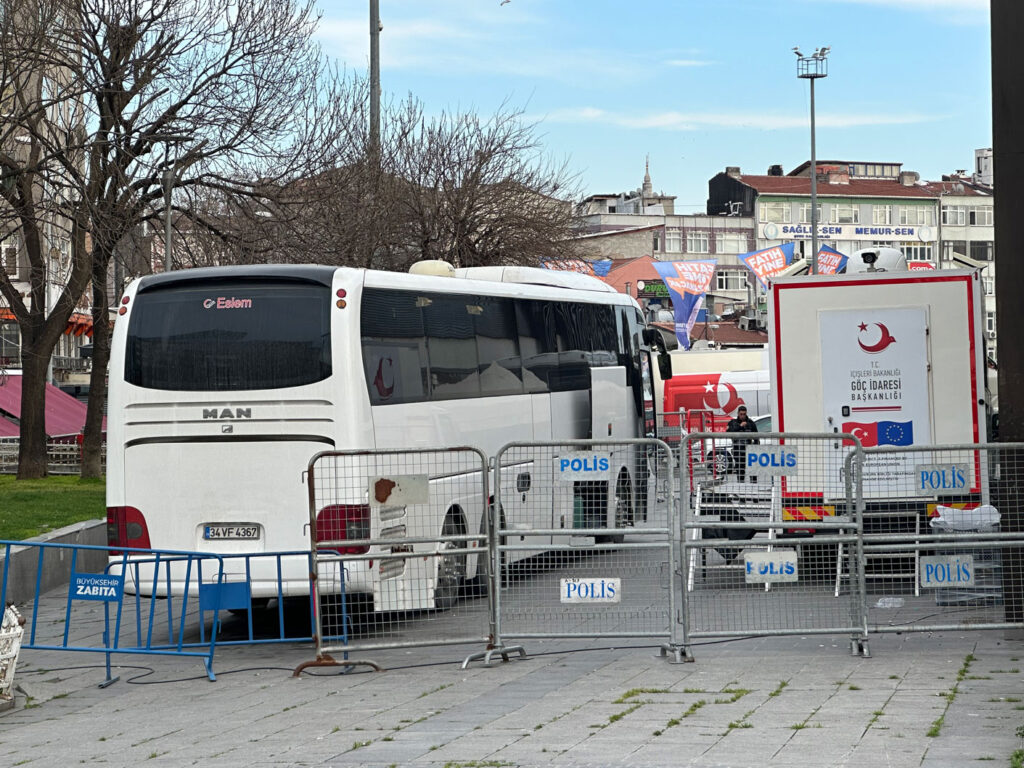
The PMM said in a response to questions by the joint investigation that mobile migration vehicles are always manned by one migration expert and one interpreter, and that the PMM carries out “[its] fight against irregular migration according to [its] civilizational values, human rights and the law.”
According to three sources in Ankara, the mobile migration vehicles project received funding from the U.K. Neither the British Embassy in Ankara nor the Foreign, Commonwealth and Development Office in London responded to this allegation. The EU, on the other hand, invested in technology used inside the vehicles. As an internal EU document from 2020 shows, Brussels provided at least 800 fingerprint scanners and invested around 10 million euros in improving a digital database called GocNet (MigrationNet) — the same database the PMM website says is used for identity checks inside the vans. Moreover, different types of vehicles bearing EU logos are also used during the apprehensions. At one central square in Istanbul, for instance, we spotted a van with an EU logo used to check the IDs of people apprehended by mobile migration teams. The back door of the vehicle bore a sign with the EU and Turkish flags and, again, that familiar phrase: “This project is financed by the European Union.”
For Erdogan’s government, this project appears to be a political boon. Nearly every month, Yerlikaya is invited by pro-government television channels to brag about his achievements in getting migration under control. “Let me give you some good news!” he said in an interview with the channel A Haber last September, as he paced through the studio with deportation statistics displayed on the large screen behind him. Since June the previous year, the minister said, the mobile migration vehicles had carried out over 1.5 million ID checks and identified nearly 190,000 “irregular migrants.” In the same period, 180,000 had been deported and some 160,000 Syrians had “voluntarily returned” to Syria. “We are the only country in the world that gets this done in this way,” Yerlikaya said, as the presenter showered him with compliments. Last year, he said, “we had the biggest deportation campaign of all time.”
Once migrants and refugees are apprehended, they move on to the second stage in the deportation process: detention in a removal center. In the same interview, Yerlikaya said there were 32 such centers operating throughout the country with a formal total capacity of nearly 20,000 detainees.
The EU began to commit funding to the centers from 2007 onward and construction began around 2012, satellite images indicate. The center outside Gaziantep in which Dawood was held was among the first to be built. It was also one of six facilities “initially planned and designed to be reception centers for asylum seekers and refugees,” the European Commission wrote in a 2022 letter to Human Rights Watch seen by these reporters. “Following the request of the Turkish Government in 2015 [the reception centers] were transformed to removal centers … in agreement with the European Commission.”
“The cost of this transformation,” the European Commision report noted, “has been financed by the Government of Turkey.”
Not all the costs, however. While the PMM paid for “iron bars to all windows” and “changing necessary doors from wood to steel,” security in the recently converted centers remained an issue, an internal report on an EU project carried out between 2016 and 2019 obtained by this investigation noted. The EU subsequently agreed to pay at least 1.4 million euros for “increasing the heights of the exterior walls” in the converted centers with security panels and barbed wire — the same barbed wire that Dawood said he looked out on from his window behind bars. As a result of this investment of European tax money, the report noted, “the escape rate reduced profoundly.”
A European Commission spokesperson said in a response to questions by the joint investigations that the investments mentioned here “refer to standard security systems in the removal centers,” and added that “overall, EU assistance to the removal centers has significantly helped Turkish authorities’ efforts to improve the physical and material conditions in the centers.”

This specific project, worth a total of 60 million euros, is only one of a dozen EU projects related to Turkey’s removal centers that we found in internal and public documents. We calculated that the total EU funding committed to projects related to the removal centers amounts to at least 213 million euros. Writing in response to our findings, a representative of the European Commission said that the total stands at just under 200 million euros, but did not provide a precise breakdown of the individual projects this money was spent on.
The EU has not been very forthcoming with such details throughout this investigation. One European Commission spokesperson, for instance, indicated that the EU has paid for the construction of 14 centers and the renovation or refurbishment of another 11. We found evidence in internal documents, however, that the EU has also paid for either extending walls or hiring staff in another nine centers not mentioned by the spokesperson (the total of this sum is higher than the 32 centers currently operational because some have closed over time).
Practically all of the EU funding to the centers has come from the so-called “Instrument for Pre-accession Assistance” (IPA). In theory, these pre-accession funds are meant to help EU candidate states such as Turkey implement the reforms required for eventual accession to EU membership. But accession negotiations between Brussels and Ankara have stalled since 2016 and the EU has suspended some IPA aid because of Erdogan’s growing authoritarianism, though the IPA support in the field of migration has continued.
Just how crucial a partner Ankara is to the EU for migration management became clear in March 2016, when Brussels and Ankara signed the so-called EU-Turkey deal. The crux of the agreement was that Ankara would take back “irregular migrants” crossing to the Greek islands in exchange for two aid packages of 3 billion euros each to help host Syrian refugees. A third tranche of 3 billion euros was added in 2021. While the vast majority of this money went to much-needed cash support, health care and education for Syrian refugees, some of the money budgeted under the EU-Turkey deal also funded projects for deportation centers — including the 60-million-euro project that paid for the barbed wire Dawood looked out on.
To be sure, EU funding also went toward improving living standards in the centers, with the EU paying for hygiene kits, blankets, pillows and even musical instruments. Several of the detainees we spoke to, however, indicated that they did not benefit from such aid. “When we entered the camp, we had to sign a piece of paper saying we would get shampoo, soap, a blanket and a pillow, but then we didn’t get it,” said Ghani, an Afghan man who worked for the British army as a translator and had to flee from the Taliban, about his time in the Kirklareli center. “There were many good things the EU paid for, like showers or football pitches. But we were not allowed to use any of that.”
Although Yerlikaya stated, in his August interview on Haberturk, that anyone was welcome to come and visit the centers “at any time,” several European diplomats indicated to us that they do not have such unrestricted access outside of prearranged visits which one diplomat described as “propaganda tours.” The U.N. Refugee Agency and the International Organization for Migration (IOM) also struggle with limited access to the centers, another diplomat noted. “They cannot monitor what they want to be monitoring.”
A European Commission spokesperson wrote that the EU does carry out regular “monitoring missions” to the centers to check how EU money is spent. The Commission did not grant our freedom of information request to obtain these reports, stating that the documents contain “critical observations” which, if shared with third parties, “could damage bilateral relations between the European Commission and Turkey.”
While conditions do vary by center and are said to have recently improved in some, interviews with former personnel, as well as several lawyers who visit the centers, in addition to just under 40 former detainees who together witnessed conditions in three-quarters of the facilities, clearly indicate that various forms of mistreatment are systemic and ongoing.
All three former and current staff we spoke with said the centers are “worse than prisons.” “The hygiene is abysmal, the food terrible, everything is dirty and the buildings are overcrowded,” said a Turkish interpreter who still works in several of the centers. Another current staff member said that the severity of the mistreatment is also related to the fact that the detainees are “not Turkish citizens,” and the staff are overworked and underpaid. “Most of them are so exhausted that they only see ‘foreigners’ as numbers,” he says.
Overcrowding is a structural problem. Many detainees told us they had to share rooms with four beds with at least eight people, and that they slept in outdoor courtyards or covered sports fields. Verified images on social media show detainees at the Tuzla center, located just east of Istanbul, crammed together in a fenced basketball court amid piles of rubbish. (The situation there is said to have recently improved, in part due to the opening of another massive removal center on the western edge of Istanbul at the end of last year.)
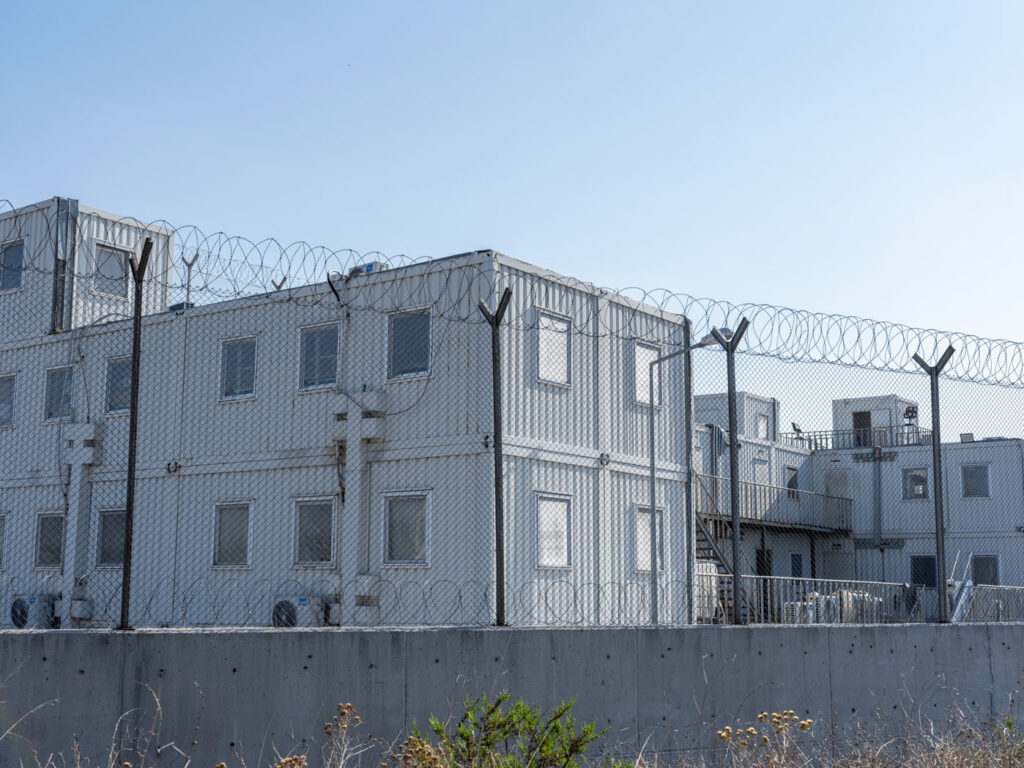
“We were crammed together like sardines” said one man from Azerbaijan, who says he was in Tuzla in the fall of 2023. “We were given one blanket for every four people and had to crawl up against total strangers to avoid freezing to death.” Another Syrian man who was detained after he survived the 2023 earthquake, when he moved to Istanbul while registered elsewhere, said that there were “rats jumping out of the sewers” in Tuzla. The overcrowding and poor hygiene have fueled the spread of diseases. “Many people had stomach diseases, dental problems and skin diseases such as scabies,” said one Syrian in his early 20s who was held in the Sanliurfa removal center in the spring. Another Syrian man detained in the same center around the same time said that he suffered from unbearable stomach pain shortly after his arrival there. Within three weeks, he said, his stomach was completely swollen with liquid and he was unable to walk from the pain, but the doctor at the center waited over two months before transferring him to a hospital. “I weighed 73 kilos when I entered Sanliurfa, and 44 kilos when I came out,” the man told these reporters during a phone call from a town in northern Syria, to which he said he was deported before his medical treatment was completed. The joint investigation has seen paper evidence of his detention at Sanliurfa as well as a recent video showing his emaciation.
On top of these reported squalid conditions, detainees are routinely beaten. About half of the detainees we spoke to said they were beaten themselves, while around three-quarters said they witnessed such violence. Four of them, as well as two lawyers, told us about “refrigerator rooms” in which “special cases” are beaten or have ice water poured over them. In a response to these allegations, the PMM said the centers are operated “with the principle of ‘zero tolerance to ill-treatment’” and denied the use of refrigerator rooms.
While almost all victims of the abuse stressed that beatings took place in areas without cameras, CCTV footage very occasionally leaks out to the press. Last November, for instance, the Turkish channel T24 published surveillance footage showing a man in his underwear with a bloodied leg being chased by guards through the corridors of the Izmir deportation center — one of the centers built with EU money. According to T24, a Syrian and a Palestinian man were both severely beaten in the incident but so far no one has been convicted.
“There is total impunity,” said Mustafa Yeneroglu, a parliamentarian who used to be a member of the ruling Justice and Development Party but switched to the opposition Democracy and Progress Party and is a strong advocate for the rights of refugees. Speaking from his office in parliament, he too says it is “well known that abuse, intimidation and coercion are systematically taking place everywhere in deportation centers. But as long as it is against foreigners, such things are considered normal in this country.”
In the Turkish city of Sanliurfa, a 17-year-old Syrian boy stood in his parents’ shop selling nuts, speaking fluent Turkish and advising his Turkish customers on which type of pistachios to buy. When the Turks left, he pointed at a broken window and recounted what happened there in early July this year.
“They came out of nothing and began to attack,” the boy said. “There were 50 of them, it was very scary.” Another shopkeeper on the same road also said his shop was attacked and showed a video of young Turkish men and even boys hitting Syrians with wooden sticks, and pictures of broken glass and drops of blood on the floor. “We have CCTV footage, but what can we do?” the shopkeeper said. “If we file a complaint with the police we’d just get deported.”
The riots that erupted in many different cities across Turkey began in the central Anatolian city of Kayseri, following allegations on social media that a Syrian man had raped a young girl. The local police chief immediately assured rioters that “the victim is not Turkish” and promised to take all necessary steps “including deportation” against the man “and his family,” but this did not calm the rioters. In the days that followed, as many as several thousand men took to the streets of Kayseri and damaged or burned an estimated 400 Syrian shops, cars, homes and other properties.
“This was a pogrom,” said Yeneroglu, the Turkish lawmaker defending refugee rights. “There is a lynching culture against Syrians and other refugees in Turkey, and that will get much worse as the economy further deteriorates. It would, unfortunately, not be the first time in Turkish history.”
Part of the government’s response, however, was to step up deportations of Syrians in an attempt to soothe the anger. Yeneroglu said that people he knew at the PMM were aware that what they were doing was wrong. “But there is a lot of fear to raise concerns. And in any case, xenophobia and anti-Arab sentiments are at [a] peak. It’s a development beyond their control.”
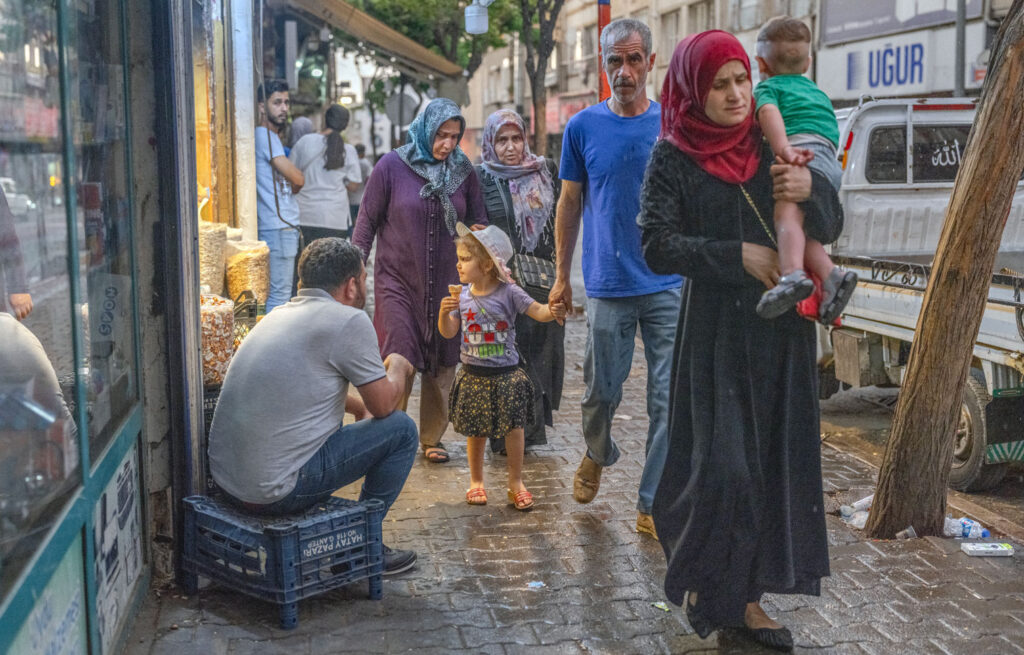
“Come on, sign,” the woman with the dyed blonde hair said, throwing a menacing look at Dawood. The former rescue worker hesitated, then thought of the man dragged out of this room just moments ago, and picked up the pen. “I signed because I did not want to be beaten,” Dawood said. “I signed to preserve my dignity.”
More than three-quarters of the detained Syrians we spoke with for this investigation said they were pressured or physically forced to sign voluntary return forms. While much of the coercion occurs inside the centers, some detainees said they were forced to sign papers right at the Syrian border. One of them was Mohammed, the Syrian earthquake survivor who had been detained in Tuzla last year. After being transferred and held in a camp by Elbeyli (the same one “Ibrahim” was held in) for another four months, he said, he was taken to the border crossing by the Turkish town of Oncupinar around midnight.
“They put us into a room and asked, ‘Who wants to go to Syria?’” Mohammed said. “Then they turned off the lights and beat the people who had said they wanted to stay in Turkey with iron bars. Then they turned the lights back on and everyone said, ‘We want to go to Syria.’” He and others were then taken to a place nearby to sign the forms. “We also had to go and stand in front of a camera and say we are going to Syria voluntarily. Some were crying while saying it, others had signs of beating on their faces.”
In response to written questions, the PMM confirmed the practice of taking “video recording of Syrians expressing their wish to return to their country voluntarily.” It denied any coercion being used, however, and said all returns to Syria were “voluntary, safe and dignified.” The PMM also emphasized that “access to legal support is provided for all detainees.”
One 2023 evaluation report of an EU project, however, states that in 2022, only 20% of detainees appointed a lawyer. The year before, that proportion stood as low as 10%. Some detainees may not be able to afford legal assistance (many reported practices of lawyers charging thousands of dollars for relatively simple procedures) but many also struggle to contact lawyers. While Turkish law clearly prescribes immediate and unrestricted access to legal aid from the moment of apprehension, several detainees we spoke with said they were held incommunicado for days and were not even able to inform friends or relatives about their detention — let alone contact a lawyer. The PMM denied these allegations and insisted that payphones were provided in the centers and those with insufficient means were given phone cards free of charge. Another major issue in terms of access to legal aid is the constant movement of detainees. While the PMM said transfers were meant to deal with “short-term overcrowding,” several lawyers and detainees we spoke with said the transfers also obstructed the legal process, as lawyers often lose touch with their clients after a first meeting.
Some places are even more out of reach of the law. Alongside the removal centers, Turkey has started using so-called “temporary accommodation centers” (TACs) as de facto detention facilities. Most of these large container camps were built shortly after the outbreak of the war in Syria to welcome refugees, but today at least some of them act as auxiliaries to Turkey’s deportation machine. By far the worst, several lawyers and detainees said, is the temporary shelter center by the town of Harran, south of the city of Sanliurfa and close to the Syrian border. When we drove around the site, we came across long walls, watchtowers and barbed wire. Some of the watchtowers, satellite imagery reveals, were constructed after mid-2018. Entangled in the barbed wire are objects including a backpack and a woman’s purse, apparent relics of past escape attempts.
“Think of this place as Guantanamo,” said Abdullah Oncel, president of the Bar Association in the nearby town of Urfa. “You can be held there for a very long time and nobody knows what happens there. Access to a lawyer is very difficult. Access to justice is impossible.”
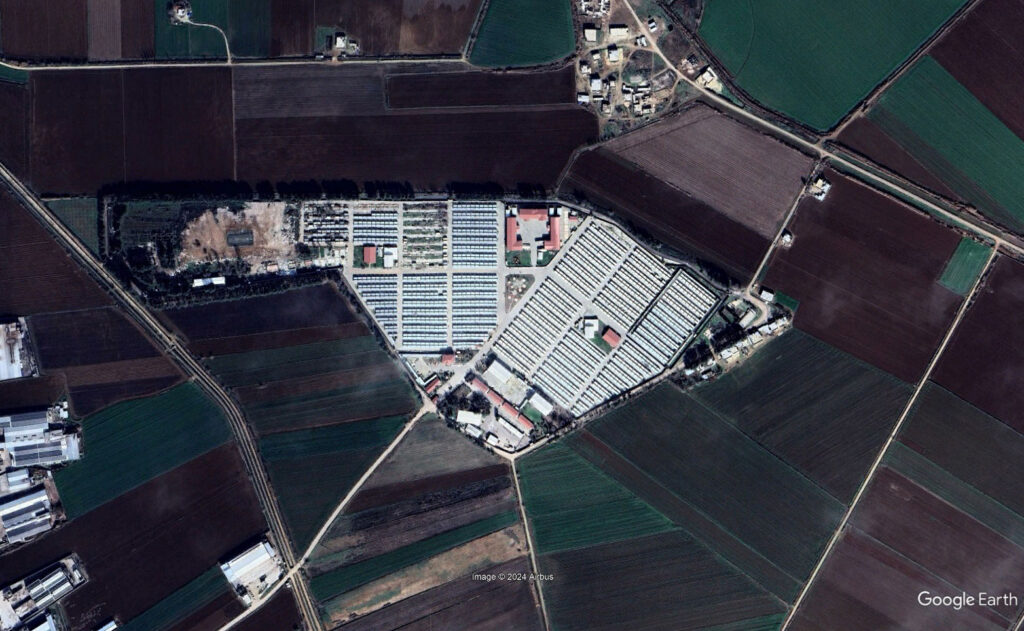
We spoke with five Syrian men and one Afghan woman held in Harran TAC. Some of them had managed to keep their phones and sent us photos and videos from inside the camp. The images showed men lingering in the scorching heat, some with serious skin infections, and young children and women standing by small containers where they sleep right next to leaking toilets. “The humiliation is unbearable,” one Syrian man wrote on the Signal messaging service from inside the camp this summer. “Today one woman stabbed herself just to get out.”
Some detainees have been able to speak to us from inside the camp. One of them was severely beaten the day before. “It was brutal, they used sticks this time,” he said, as he briefly opened the camera on his friend’s phone and showed a bloodied and bruised chest. His friend confirmed he witnessed the abuse. All of the five Syrian men who had stayed there mentioned suicide attempts occurring inside the camp. “There’s been so many suicide attempts I can’t even count them,” one said. “People here are psychologically destroyed.” Both the EU and the PMM said that Harran TAC has received no EU funding. The PMM also denied the reports about beatings of detainees by staff and suicide attempts, and insisted that “there is absolutely no practice of using temporary accommodation centers … as removal centers” — a claim contradicted by accounts of detainees who stayed not just in Harran TAC but also in Elbeyli (such as “Ibrahim” and “Mohammed”), which also is a “temporary accommodation center.”
The PMM did, however, confirm the deaths of three detainees held in various EU-funded centers since October last year. It said the deaths were due to medical conditions or referred to previous statements issued by the Turkish authorities alleging the same. The most recent of these cases is that of a 37-year-old Syrian man named Ibrahim Izziddin, who died on July 16 this year, days after being detained at Kirklareli — one of the centers constructed with EU funds (the joint investigation has a copy of his death certificate). A week later, and following a report in the Turkish newspaper Karar that the Syrian man had died after being beaten, the Kirklareli governor issued a statement that Izziddin “lost his life with a preliminary diagnosis of massive pulmonary embolism … and the autopsy report did not contain any signs of assault or force.”
Ibrahim’s brother doubts this is true. He told us in a phone call from his home in Germany that three days after Ibrahim’s death he was contacted by two different Syrians who each independently told him that they had stayed in the same center as Ibrahim and were deported immediately after his death. Both men said Ibrahim received death threats from one of the security guards and one confirmed he had been badly beaten the night before he died, the brother said. Early the next morning, one of the men who called said, Ibrahim had started to foam from his mouth and called for help, but was told to shut up, and it was only when the guards changed shifts that an ambulance was called in. “That man told me Ibrahim knew he was dying and had asked him to tell his son that his father loves him.”
The joint investigation wrote to the governor of Kirklareli to request a copy of the autopsy report but received no reply. The brother, too, said he had received no such report. The original article in the Turkish newspaper Karar was blocked by the Turkish authorities.
“This raises a lot of interesting legal questions,” said Tom de Boer of the law firm Prakken d’Oliveira in Amsterdam, which this year sued the Dutch state on behalf of a number of NGOs over its involvement in the EU-Turkey deal. De Boer said there may also be ways of holding the EU liable for human rights violations in EU-funded centers. “Both the EU and member states have a duty of care not to actively contribute to human rights violations, including outside their own territory. So you would have to examine whether the EU knew, or should have known, the risks of human rights violations and whether they chose to continue funding regardless.”
Awareness of such risks is widespread, interviews with over a dozen European diplomats and officials in both Brussels and Turkey indicate. Practically all of them indicate being aware of reports by NGOs such as Amnesty International and Human Rights Watch, which have reported on violations in EU-funded centers and illegal deportations to Syria since at least 2015. On top of that, the European Court of Human Rights ruled in 2022 that Turkey forcibly deported a Syrian refugee after forcing him to sign a “voluntary return form,” and the 2020 annual “Turkey report” by the European Commission notes that “there have been cases of migrants being forced into signing voluntary return forms.” “They know. Everybody knows. People close their eyes,” said a former commission official, who confirmed that there was “a constant concern” that reported violations at EU-funded centers would end up posing reputational and legal risks to the bloc.
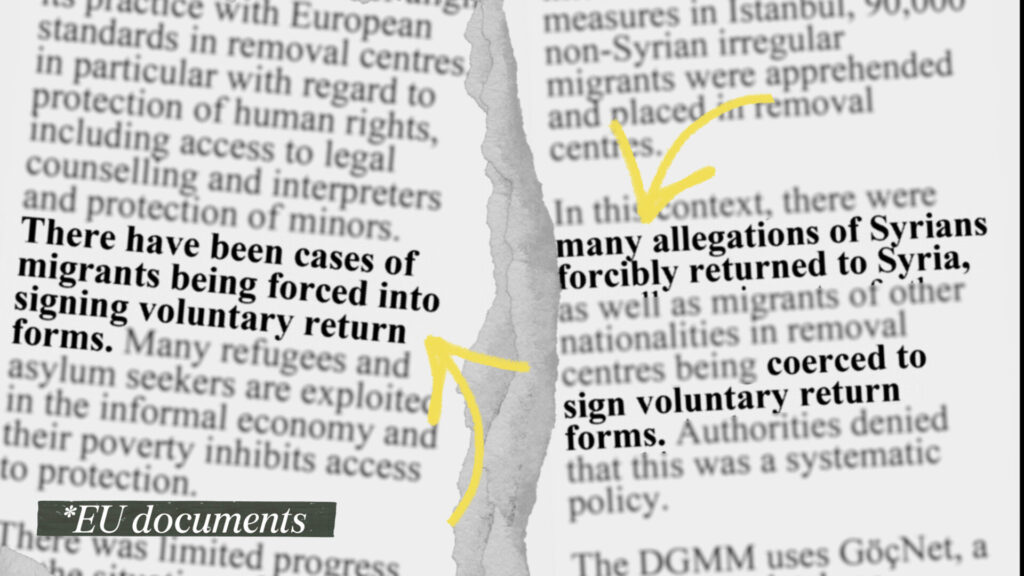
But the EU’s policy did not change — quite the contrary. When Brussels pledged the third payment of 3 billion euros in aid under the Turkey deal in 2021, 250 million went to border and migration management. The same former commission official said that the outgoing EU commissioner for neighborhood and enlargement, Oliver Varhelyi, who took office in 2019, was even “super happy” about reports that Turkey was deporting Afghans en masse and internally advocated for exploring ways to support Turkey in returning Syrians. Varhelyi has also pushed recent migration deals with Egypt and Tunisia and is a party colleague of the radical-right Hungarian Prime Minister Viktor Orban.
Six European diplomats of five nationalities stationed in Turkey who spoke with us on condition of anonymity said they were also well aware of the reported violations in the centers. One of them called it “the unmissable topic nowadays.” Another said, “EU-funded ‘reception centers’ have been turned into de facto prisons.” Several of the diplomats indicated to us that they regularly raise these concerns with their respective governments and at the EU delegation in Ankara.
But confronting Turkish counterparts proves more difficult. The Turks simply deny all allegations about the forcible deportations, one diplomat said, and without more oversight by U.N. and EU agencies, it is hard to know how “systemic” the abuses are. “We are not being that confrontational,” another diplomat said. “We just ask the Turks, ‘How do you ensure that return is voluntary?’ Then they say, ‘Everything is voluntary, because people sign a form and have access to lawyers.’ That’s usually the end of the conversation.”
One early October morning last year, Dawood was woken up by the guards at the Gaziantep center and told to get ready. “They made us sit outside in the basketball court with around 50 to 60 people, and put us onto a bus,” said Dawood, who was deported that day through the border crossing between the Turkish town of Karkamis and the Syrian town of Jarabulus. The joint investigation has seen a photo of a stamped and dated entry paper with his full name, issued by the Jarabulus border crossing.
Even in this final stage of the deportation process, Turkey seemingly uses EU-funded equipment. When we visited the Turkish side of that same border crossing in August, we spotted a white passenger bus with a PMM logo and an EU flag on its front door. In a written response to questions by the joint investigation, a European Commission spokesperson said that “there are no reports suggesting that EU-funded equipment, such as … vehicles, are used for other purposes than the ones intended for.” “As always,” the spokesperson added, “any allegations will be investigated should evidence be provided.
At this same border crossing and another one at the Turkish town of Oncupinar, we also met Syrians carrying suitcases who told us that they had themselves decided to leave. Even in some of these cases, though, it remains debatable how “voluntary, safe and dignified” their return to Syria really is. One old couple, for instance, said they were leaving because their son was deported. Another woman with a baby said she had tried but failed to obtain a valid ID, so it was better to leave.
While public Turkish statistics register all returns to Syria as “voluntary,” the most used Syrian border gate of the four routinely used by Ankara to deport Syrians, a gate known as Bab al-Hawa, does distinguish between “deportations” and “voluntary returns” in the statistics published on its website. Since April this year, Bab al-Hawa has registered around 11,000 voluntary returns and 10,000 deportations. Another border gate at Bab al-Salama only uses the term “voluntary returns.” “The Turks asked us to use that word to increase the government’s credibility,” a Syrian source at that border told us on condition of anonymity. “They want us to hide the reality.”
Once they have crossed the border, Syrians find themselves in territory controlled by Hayat Tahrir al-Sham, in the case of Idlib province, and the Turkey-backed rebels of the “Syrian National Army,” in the case of Afrin, Azaz and the area around Tell Abyad. Both groups are known to have engaged in arbitrary arrests, kidnappings, torture and extortion. Moreover, the area is still regularly bombed by the Assad regime and Russian warplanes, and the humanitarian situation is catastrophic: 3.6 million of the 5 million in northwestern Syria remain internally displaced, and 80% of the population is dependent on humanitarian aid, according to the U.N.
The Syrians deported here are “the weakest link in the area,” said a Syrian aid worker in Gaziantep who works in northwestern Syria. “They have no clothes, no SIM card and often their families don’t even know where they are. Many of them sleep in mosques and military bases and are extremely vulnerable: They do any job to make ends meet and can be recruited by anyone.”
That is exactly what happened with Dawood. When he failed to find work in Jarabulus and decided to move to Idlib, he was approached by fighters of the Sultan Murat Brigade who offered him a job in Niger — one of the more recent destinations to which Syrian mercenaries have been sent through Turkish intermediaries (previous ones included Libya and Azerbaijan). “They said I would get $3,500 a month and would not have to fight,” said Dawood, who showed the WhatsApp group of potential recruits to which he was added. “For some, it is the only way out. But I don’t want to be a mercenary,” he said.
Instead, Dawood paid $2,600 for a smuggler to bring him back to the country that had just deported him. He is far from the only one: Several other Syrians we spoke with tried to get back to Turkey and succeeded, but the road is a dangerous one. “On my way, I saw many people who were brutally beaten by border guards,” said Dawood. “We tried and failed 12 times to cross. But the 13th time, we made it, and a smuggler took me all the way to Istanbul. Thank God, because many of the guys who went to Niger are now dead.”
Syrians who return to Turkey after deportation have little or no future prospects there. They are unable to renew their Turkish ID cards, if they ever had them, and they can be apprehended and deported again at any time. Alongside many other Syrians — and other refugees and migrants in Turkey — even among those with valid documentation, it seems the goal of reaching Europe has become paramount.
Indeed, according to U.N. Refugee Agency statistics, irregular arrivals from Turkey to Greece increased threefold in 2023 compared to the previous year, to nearly 50,000, coinciding with the presidential elections that were held as Ankara decided to speed up removals of “irregular migrants.” Fear of deportation, several diplomats said, is one of the factors currently pushing people to Europe. “It’s a total failure,” one diplomat said of the EU’s policy to invest in Turkey’s deportation centers. “Not just in terms of human rights, but also in terms of migration management.”
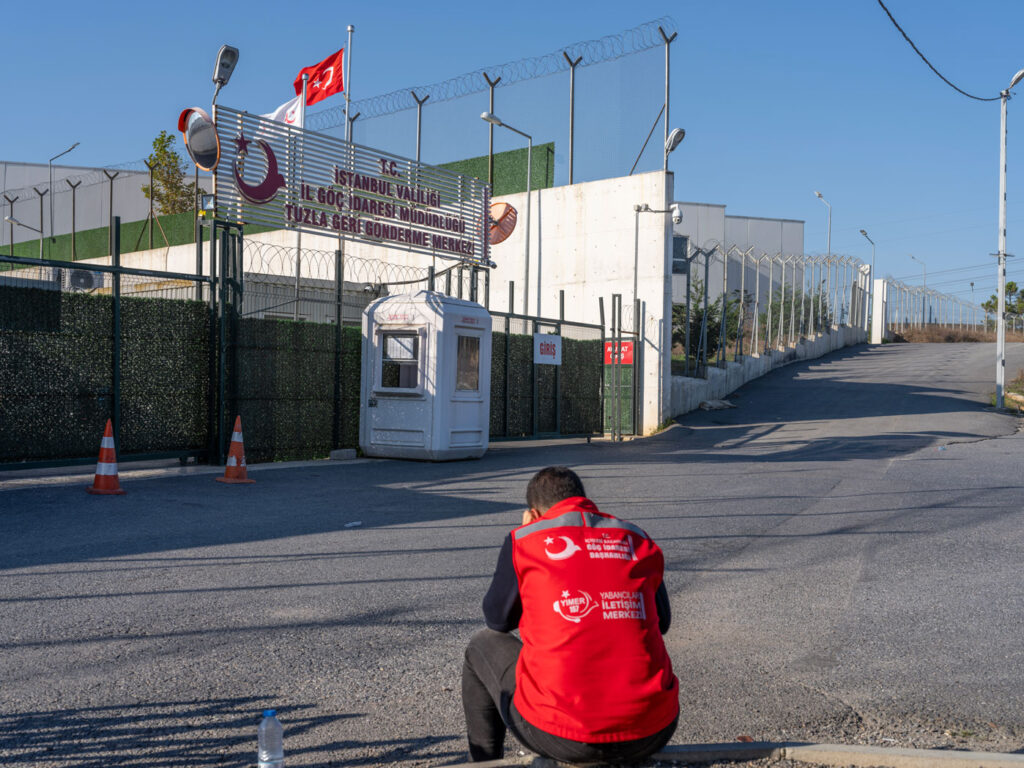
Meanwhile, in Brussels, EU officials are debating how exactly to spend a new aid package of 2 billion euros, which the bloc allocated to Turkey in February. Potential new funding for the centers is part of that discussion, the Dutch Foreign Ministry confirmed. One EU diplomat said, “There is an expectation to increase the funding for migration and border management, because this was a commitment by our commissioner.”
Dawood now lives a life in hiding in a Syrian restaurant on the outskirts of Istanbul, where friends have offered to shelter him. One of them is a former colleague who also volunteered with the Syrian Civil Defence. “We’ve gone through a lot together,” Dawood said. “We’re like brothers.”
For the past several months, Dawood said, he has only left this place once. He sleeps at the back of the restaurant and keeps his few belongings — some neatly folded shirts, a blanket, a bottle of perfume — in the wardrobe next to the toilets. Each day, he does 60 situps and 60 pushups to stay sane. The rest of his time is spent working in the kitchen to pay off the debts he incurred for the previous smuggler and save up money for another one to take him to Europe — just like he did a year ago.
“All I want is to be treated like a human again,” said Dawood. His relatives in Europe have offered to send him money, but the former rescue worker said he prefers to save himself this time. Asked why, he jokingly flexed a bicep and said, “Because I’m a man.”
The authors of this piece were part of a joint investigation coordinated by Lighthouse Reports, also published in El Pais, NRC, Al Jumhuriya, Politico, Der Spiegel, L’Espresso, Le Monde, Syrian Investigative Reporting for Accountability Journalism (SIRAJ) and Etilaat Roz. The investigation received funding from IJ4EU and Journalismfund Europe. For the full Lighthouse investigation click here.
Reporters on this investigation included Andrés Mourenza (El Pais), Melvyn Ingleby (NRC), Ylenia Gostoli (L’Espresso), Mesut Tatuz (Al Jumhuriya), Mohannad Al-Najjar, Şebnem Arsu, Muriel Kalisch and Steffen Lüdke (Der Spiegel), Zia Weise (POLITICO), Nicolas Bourcier (Le Monde), Mohammad Bassiki (the Syrian Investigative Reporting for Accountability Journalism Association), Jalil Rawnaq (Etilaat Roz), independent journalists Mahmoud Baffakh, Giacomo Zandonini and J. Jalali and May Bulman, Fahim Abed, Bashar Deeb, Elena DeBre and Charlotte Alfred from Lighthouse Reports.
Become a member today to receive access to all our paywalled essays and the best of New Lines delivered to your inbox through our newsletters.
